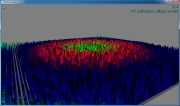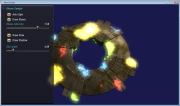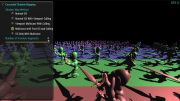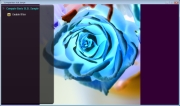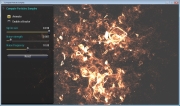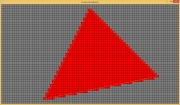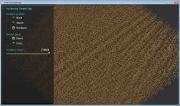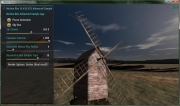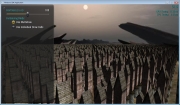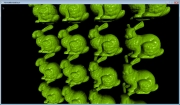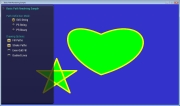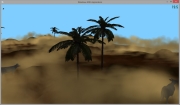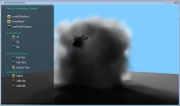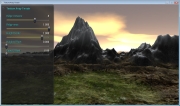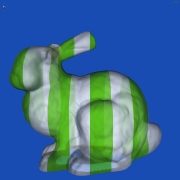OpenGL Graphics and Compute Samples
Bindless Graphics Sample
This sample demonstrates the large performance increase in OpenGL that is made possible by 'Bindless Graphics.' These extensions allow applications to draw large numbers of objects with only a few setup calls, rather than a few calls per object, thus reducing the driver overhead necessary to render highly populated scenery.
BlendedAA Sample
This sample implements a two-pass additive blending anti-aliasing technique using Target-Independent Rasterization (TIR), which should give comparable results to MSAA with a reduced memory footprint.
Bloom Sample
This sample demonstrates creating a glow effect by post-processing the main scene. It heavily leverages FBO render targets across multiple steps/passes with custom effects processing shaders. It also integrates shadow mapping to demonstrate self-illumination cutting through the shadow effects.
Cascaded Shadow Mapping
This sample implements the cascaded shadow mapping technique using Viewport Multicast and Fast Geometry Shader.
Compute Basic GLSL Sample
This basic sample demonstrates how to interoperate between OpenGL [ES] and a simple OpenGL Compute Shader-based compute kernel.
Compute Particles Sample
The Compute Particles sample shows how OpenGL Compute Shaders can be used along with OpenGL rendering to create complex animations and effects entirely on the GPU.
Compute Water Surface Sample
This sample demonstrates dynamic, interactive water surface animation using compute shaders.
Conservative Rasterization Sample
This sample demonstrates the pixel-level effect of enabling the conservative rasterization feature supported in OpenGL. It allows applications to shade every pixel whose area is touched by a fragment, rather than only those touching specific samples.
Feedback Particles Sample
The Feedback Particles sample shows how normal vertex shaders can be used to animate particles and write the results back into vertex buffer objects via Transform Feedback, for use in subsequent frames. This is another way of implementing GPU-only particle animations. The sample also uses Geometry Shaders to generate custom particles from single points and also to kill the dead ones.
FXAA Sample
This sample presents a high performance and high quality screen-space software approximation to anti-aliasing called FXAA.
Instanced Tessellation Sample
This sample demonstrates how instancing can be used to efficiently tessellate objects in real-time.
Instancing Sample
This sample demonstrates how instancing techniques can be used to speed up drawing operations for scenes that consist of many copies of the same object rendered with slight differences.
Motion Blur ES2 Sample
This sample shows a method of simulating motion blur of fast-moving objects using multi-pass rendering. In the first pass, the fast-moving geometry is rendered unblurred into a framebuffer object. In the second pass, a special vertex shader stretches the geometry between the previous and current vertex position based on the normal at the vertex and apparent shutter duration (stretch length), and the fragment shader applies supersampling to the first pass results to generate a blurred visual.
Motion Blur GL4/GLES3 Advanced Sample
This sample shows a filtering method for simulating motion blur of fast-moving objects. The method used is a 2D full-screen post-process that works on a normal framebuffer augmented with a screen-space velocity buffer; thus, filtering performance is not dependent on scene geometric complexity. The algorithm is based on the paper 'A Reconstruction Filter for Plausible Motion Blur', by McGuire et. al. (SIGGRAPH I3D'12)
Multi-Draw Indirect Sample
This sample demonstrates how to use extensions to OpenGL to offload the CPU in generating rendering work when you have a large number of objects in a scene. The extensions and core features used are a subset of the features commonly known as 'AZDO' (For Approaching Zero Driver Overhead).
Normal Blended Decal Sample
The Normal Blended Decal Sample demonstrates how to use the OpenGL PSI (Pixel Shader Interlock) feature to blend normals when drawing screen-space decals. This sample compares the performance of PSI with glMemoryBarrier.
NVPR Basic Path Rendering Sample
This sample uses NVIDIA's Path Rendering extensions to demonstrate rendering stroked and filled 2D line-art, such as you would implement with Skia, SVG, or HTML Canvas, fully leveraging the power and speed of OpenGL hardware.
NVPR Cursive Text Sample
This sample demonstrates how to use NV_path_rendering to animate the dash pattern of a stroked path, as a way to simulate live cursive writing.
NVRP Shaped Text Sample
This sample demonstrates sophisticated text layout using the open source HarfBuzz text shaping engine library to position glyphs for strings of Unicode text.
NVRP Text Wheel Sample
This sample demonstrates using the NV_path_rendering OpenGL extension to draw text arranged like spokes in a wheel, with a slight 3D projection applied to the rendering.
NVPR Tiger 3D Sample
This sample shows how NV_path_rendering content and conventional 3D graphics can be mixed in the same 3D scene.
NVPR Tiger Warp Sample
This samples draws the so-called 'PostScript Tiger' artwork, consisting of 240 paths specified as cubic Bezier curves and line segments.
Optimization Sample
The Optimization Sample demonstrates several generic performance-improving rendering techniques. These include down-sampled rendering and depth pre-passes. The sample also demonstrates the use of app-level GPU and CPU timers, which allow apps to create focused timings of actual GPU work. This is extremely important, since it is otherwise difficult to actually determine parallel CPU and GPU timings.
Particle Upsampling Sample
The Particle Upsampling sample uses a combination of rendering techniques to simulate a cloud of particles casting shadows on a model and a floor object. The particles are rendered into a lower-resolution offscreen surface, and then up-sampled to the screen to lower the cost of the high depth complexity.
Skinning Sample
This sample demonstrates how to render skinned meshes using both one or two bones in a vertex shader. Skinning allows organic shapes (such as humans) to deform nicely around joints as they bend. Without skinning, joints have a rigid appearance that is more similar to a mechanical joint like you would see in a robot.
Soft Shadows Sample
This sample shows two methods of simulating soft shadows with complex casters and receivers. The Percentage-Closer Soft Shadows method includes a convincing impression of the shadow edge (penumbra) sharpening as the shadow caster approaches contact with the shadow receiver.
Terrain Tessellation Sample
This sample shows how OpenGL hardware tessellation support can be used to implement a highly-efficient terrain engine that supports high geometric detail.
Texture Array Terrain Sample
This sample demonstrates how to use a Texture Array to render a terrain with visually-complex texturing at high performance. The texture array is similar to a 3D texture, allowing for multiple 'slices' or sub-textures bound to a single texture ID, but arrays are much higher performance due to disallowing trivial filtering across the slices. We get great terrain rendering performance by eliminating the need to perform multiple, blended passes over the geometry, and improved quality by avoiding boundary issues that would occur with 2D atlas texturing.
Weighted Blended OIT Sample
Weighted Blended OIT Sample demonstrates how plausible OIT (Order Independent Transparency) can be rendered in a single geometry pass without any depth sorting, as described in McGuire and Bavoil 2013. The idea is to use additive blending to compute a weighted average of the translucent colors with a weighting function that falls off as the linear depth increases. This sample compares the quality and performance of Weighted Blended OIT with Depth Peeling.
